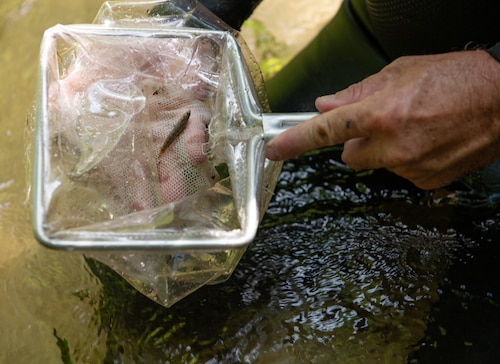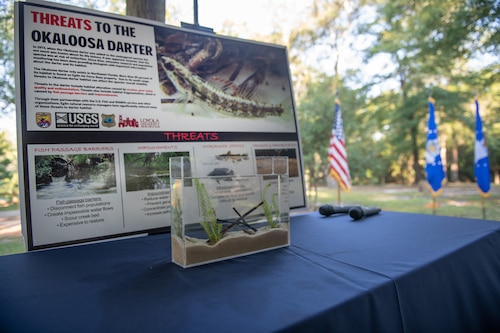The U.S. Fish and Wildlife Service announced the removal of the Okaloosa darter from the endangered and threatened species list during a ceremony Aug. 2 at Eglin Air Force Base.
The Okaloosa darter is a two-inch, perch-like fish unique and critical to the balance of six clear stream systems within Eglin and draining into two Choctawhatchee Bay bayous in Walton and Okaloosa counties in northwest Florida.
When it was listed as endangered in 1973, there were approximately less than 1,500 individual darters. This year on the 50th anniversary of the Endangered Species Act, Eglin AFB's natural resource managers estimate the darter's population to be more than 600,000. It was officially deemed recovered by the USFWS on July 28.
"More than 30 years of best management practices and partnerships with the USFWS, the Florida Fish and Wildlife Conservation Commission, and the efforts of many others led to the recovery of the Okaloosa darter," said Brig. Gen. Jeffrey Geraghty, 96th Test Wing commander. "We are grateful to everyone who brought this fish back from the brink of extinction to a thriving population on Eglin."
More than 120 people attended the event at Anderson Pond near the darter's habitat, including Department of Interior Assistant Secretary for Fish and Wildlife and Parks Shannon Estenoz and Assistant Secretary of the Air Force for Energy, Installations, and Environment Dr. Ravi Chaudhary, 96th TW leadership and members of the local community.
"The staff at Eglin have proven to be incredible conservation engineers. They designed and implemented the recovery of the Okaloosa darter and are steadily and strategically rebuilding the entire ecology of this landscape with no loss to the flexibility of the military mission." Estenoz said.
The darter's conversation and recovery are due to environmental stewardship and enduring partnerships between Eglin AFB's environmental management program, The Eglin Natural Resources Management Team, also known as Jackson Guard, the USFWS, the Florida Fish and Wildlife Conservation Commission and several federal, state and local organizations.
"This recovery program is a shining example of how effective partnerships work," said Bill Tate, USFWS Okaloosa darter recovery lead. "The USFWS, along with Eglin Natural Resources, coordinated the recovery program and capitalized on the expertise and resources available to ensure the best decisions are made for the species."
According to Bruce Hagedorn, 96th Civil Engineer Group National Resources chief, the most impactful management practices to protect the darter were erosion control, eliminating fish passage barriers and habitat restoration of the creeks on the installation, where 90% of the darters live.
Hagedorn added that these efforts led to the restoration of 363 sites across 627 acres and kept 101,000 tons of sediment from reaching darter inhabited streams.
"Thank you to the entire team for your grit, your stamina, tireless research, partnering across agencies across the decades and for keeping this journey alive," Chaudary said about the incredible effort to accomplish this goal.
To learn more about the species and the recovery efforts and visit the Federal Registry.








